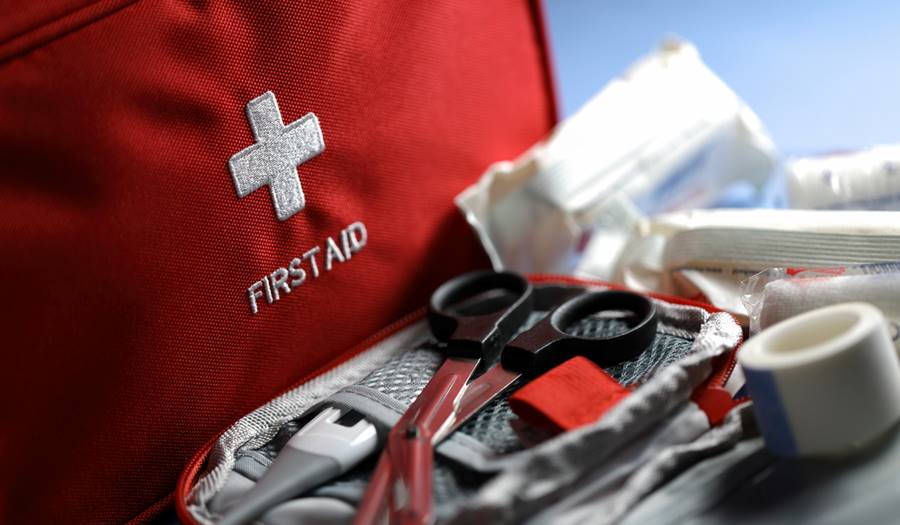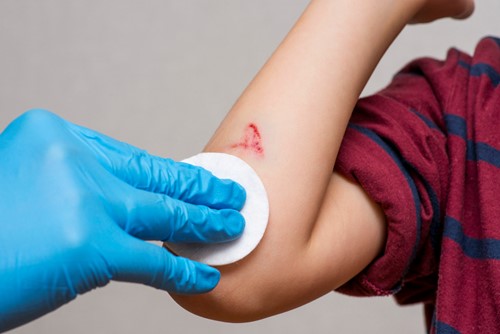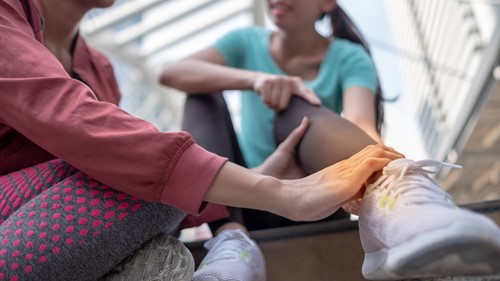
First Aid
7/25/2022
From scraped knees to splinters to burns, injuries happen when your child is learning, growing, and exploring the world. Learning how to respond to these injuries, including basic first aid, when to seek further care, and what to stock in your first aid kit, can help you feel prepared and calm during an emergency.
FIRST AID KIT
Having a well stocked first aid kit will help you easily treat and address any small emergencies. What should your kit contain?
- Bottled water (for hydration or cleaning wound)
- Medications
- Ibuprofen and/or Acetaminophen
- Benadryl
- Asthma medications if needed
- Epipen if needed
- Dramamine for motion sickness
- Topical Medications
- Antibacterial ointment
- Hydrocortisone cream
- Anti-itch cream such as Benadryl cream or calamine lotion
- Wound Care items
- Gauze-squares and/or rolled gauze bandages
- Bandaids (various sizes)
- Self-adherent (Coban) or ace wraps
- Gloves
- Medical tape
- Tweezers
- Alcohol wipes (for cleaning/disinfecting tweezers, not for skin)
- Cool compresses
- Baby wipes
- Zip-loc bag
FIRST AID TECHNIQUES
Knowing how to address common injuries or conditions can help ensure best outcomes for your child. Sometimes, your treatment will be all that your child needs. Other times, the immediate treatment you provide will allow you time to seek further evaluation and treatment from a health care professional while keeping your child safe and comfortable.

WOUNDS
Cuts
If your child cuts themselves and is bleeding, apply pressure with a clean piece of gauze or a cloth for 5-10 minutes to stop the bleeding. Try to leave the cloth on the wound for the 5-10 minutes as repeatedly lifting to evaluate the wound may prolong bleeding. If the wound was caused by an object puncturing the skin, do not remove the object and seek medical care.
Once the bleeding stops, clean the area with water and soap, wound wash, or soak the area in soapy water. Do NOT use hydrogen peroxide, betadine, or alcohol as these products may damage the skin. After cleansing, apply antibiotic ointment and a bandage.
A cut or laceration may need further repair if it:
- Goes all the way through skin
- Is gaping open and you can see dark red muscle or yellow fat
- Is more than ½ inch long and gaping open
- Crosses the lip line
Laceration repair should be done before 24 hours but the sooner the better. Do NOT let the wound dry out while waiting for repair. Lacerations can be closed with stitches, glue, steri-strips, or staples.
Skin glue works well on lacerations that are straight and not gaping widely. It cannot be used in an area of high tension such as over joints. It also needs to be kept dry for a few days. The glue itself may sting slightly but application is mostly painless. Most glues are antimicrobial meaning they can help prevent infection. Antibiotic cream should NOT be applied as it may dissolve the glue.
Steri-strips are narrow pieces of adhesive that work well to close small, shallow wounds. They cannot be used in high tension areas. Steri-strips should be kept on for a minimum of 3 days to allow the wound to heal.
Staples are generally used for scalp wounds. They can be applied quickly with minimal pain. They need to be removed after the wound heals.
Stitches work well in areas that have high tensions or for longer and deeper wounds. These can take time to put in and are painful. Because inserting them is painful, they often require numbing medication to be injected. Stitches need to be taken out after the wound heals. This process is painless. The time for healing depends on where on the body the laceration is located but can be upwards of 10 days later.
After the wound heals, apply sun protection as new skin is more susceptible to burns and burning a scar can result in permanent skin darkening. You can also apply scar cream or scar silicone sheets to help reduce the risk of scarring.
Splinters
If your child gets a splinter, attempt to remove the splinter with tweezers that have been cleaned with rubbing alcohol. This will help reduce the risk of introducing bacteria into the wound. Medical care may only be necessary for large splinters that cannot be removed. After removing the splinter, wash the wound with water and soap and apply an antibiotic ointment.
Burns
Burns are caused by the skin coming into contact with something hot. Burns are staged by degrees. A first degree burn will result in red skin but no blisters. A second degree burn will have red painful skin with blistering. A third degree burn results in charred or white skin.
For minor first and second degree burns, run the burn under cool water and cover with an antibiotic cream and a bandage. Do NOT break blisters. Do not apply butters or oils to the area. You may administer ibuprofen or acetaminophen for pain.
For the following type of burns, seek medical care:
- Electrical burn
- Any 3rd degree burn
- Any 2nd or 3rd degree burn covering an area larger than your child’s hand
- Any 2nd or 3rd degree burn on hands, face, feet, genitals, or over a joint
Bites
Bug bites are itchy and annoying but most of the time self-resolve. For comfort you can apply hydrocortisone and give antihistamines such as Benadryl. You can also apply a cool compress.
Animal bites, including human bites, should be evaluated by a medical professional. Initially, wash the area with soap and water or a wound wash. Animal bites may require oral antibiotics and a tetanus shot if your child’s tetanus vaccination is out of date.
If your child is bit by a dog that is not your own, make sure to get the owner’s information and the documentation of any rabies vaccine for the dog. If the dog is not vaccinated or the records cannot be provided, your child may require rabies vaccination. This is also true for many wild animal bites.
Bee Stings
If your child is stung by a bee or wasp, remove the stinger by scraping it with a firm object. Apply a cool compress to the area. You may also give ibuprofen or acetaminophen for pain.
If your child has an allergic reaction, please give Benadryl and have your child evaluated by an emergency care provider or call 911 depending on the severity of the reaction.
INJURIES
Fractures
Breaking a bone is the 4th most common injury in children with up to 50% of kids experiencing a broken bone during childhood. Despite being a common injury, it can sometimes be hard to tell if a younger child breaks a bone. Their bones are more flexible than adults and absorb shock better than adults. Sometimes this results in more subtle presentations!
Signs of a broken bone can include swelling, pain, large protrusions or physical deformities, and sometimes an unwillingness to move that area. Any suspected fracture should be evaluated by a medical professional. During transport or while waiting to be seen, you can use a splint or sling for comfort, ice, and ibuprofen or acetaminophen. If the bone breaks the skin or you cannot move the child, call 911.

Sprains
Sprains are when the ligaments around a joint are stretched or broken. This can result in pain, swelling, and inability or unwillingness to move that area of the body. If your child suffers a sprain, have your child rest and elevate the affected area. They should apply ice for 15 minutes every hour. You may also apply a brace or splint to the area. Your child should rest until their pain and mobility improve.
Dental Injury
If your child knocks out a tooth, call your dentist immediately. If it is a permanent tooth you can try to reinsert it or keep the tooth wet either in milk, a wet cloth, or in your child’s cheek.
If your child cracks a tooth, rinse their mouth with warm water and apply a cool compress. Your dentist should be called immediately.
Eye Injury
If your child gets a chemical in their eye, call poison control (800-222-1222) immediately and start flushing their eyes with clean water. Eyes should be flushed for 15 minutes. Do not allow your child to touch or rub their eyes. Seek care immediately if recommended by poison control
If your child’s eye is punctured with an object, do NOT remove the object. Seek emergency care immediately.
OTHER EMERGENCIES
Allergic Reactions
If your child has an allergic reaction to a food or bee sting, they may present with hives, throat clearing, shortness of breath, vomiting, and irritability. Give your child Benadryl and either report to the emergency room or call 911 based on the severity of reaction.
If your child has an Epi-pen, administer the epinephrine immediately and seek care in the emergency room even if the reaction improves after medication. Your child will need to be monitored for a rebound reaction.

Nosebleeds
If your child gets a nosebleed, have them sit forward. Sitting back can cause blood to go down the back of their throat which can cause gagging and vomiting. Pinch the soft part of their nose and apply a cool compress to their nose for 10 minutes. Do not let go of the pressure during this time to check bleeding as it can prolong bleeding. After the bleeding stops, apply vaseline to the inside of their nose to help keep the area moist and promote healing. Do not allow your child to blow their nose or pick their nose as it can restart the bloody nose.
Your child should be evaluated in the ER with heavy bleeding lasting longer than 30 minutes or if the nosebleed was due to trauma and their nose looks broken.
Ingestion of Poison/Chemicals
If your child accidentally ingests medications or chemicals, please call poison control immediately (800-222-1222) and they will direct your child’s care based on the substance ingested.
This guide will help you with most common emergencies parents face with children. Being prepared, both knowing what to do as well as having a well stocked first aid kit, can help improve outcomes for your child as well as reduce anxiety when accidents or injuries happen. Next time we will learn more about head injuries and concussions including what to do right away, signs to watch out for, and more long term concussion symptom management.
Children’s Health Care of Newburyport, Massachusetts and Haverhill, Massachusetts is a pediatric healthcare practice providing care for families across the North Shore, Merrimack Valley, southern New Hampshire, and the Seacoast regions. The Children’s Health Care team includes pediatricians and pediatric nurse practitioners who provide comprehensive pediatric health care for children, including newborns, toddlers, school aged children, adolescents, and young adults. Our child-centered and family-focused approach covers preventative and urgent care, immunizations, and specialist referrals. Our services include an on-site pediatric nutritionist, special needs care coordinator, and social workers. We also have walk-in appointments available at all of our locations for acute sick visits. Please visit chcmass.com where you will find information about our pediatric doctors, nurse practitioners, as well as our hours and services.
Disclaimer: this health information is for educational purposes only. You, the reader, assume full responsibility for how you choose to use it.








